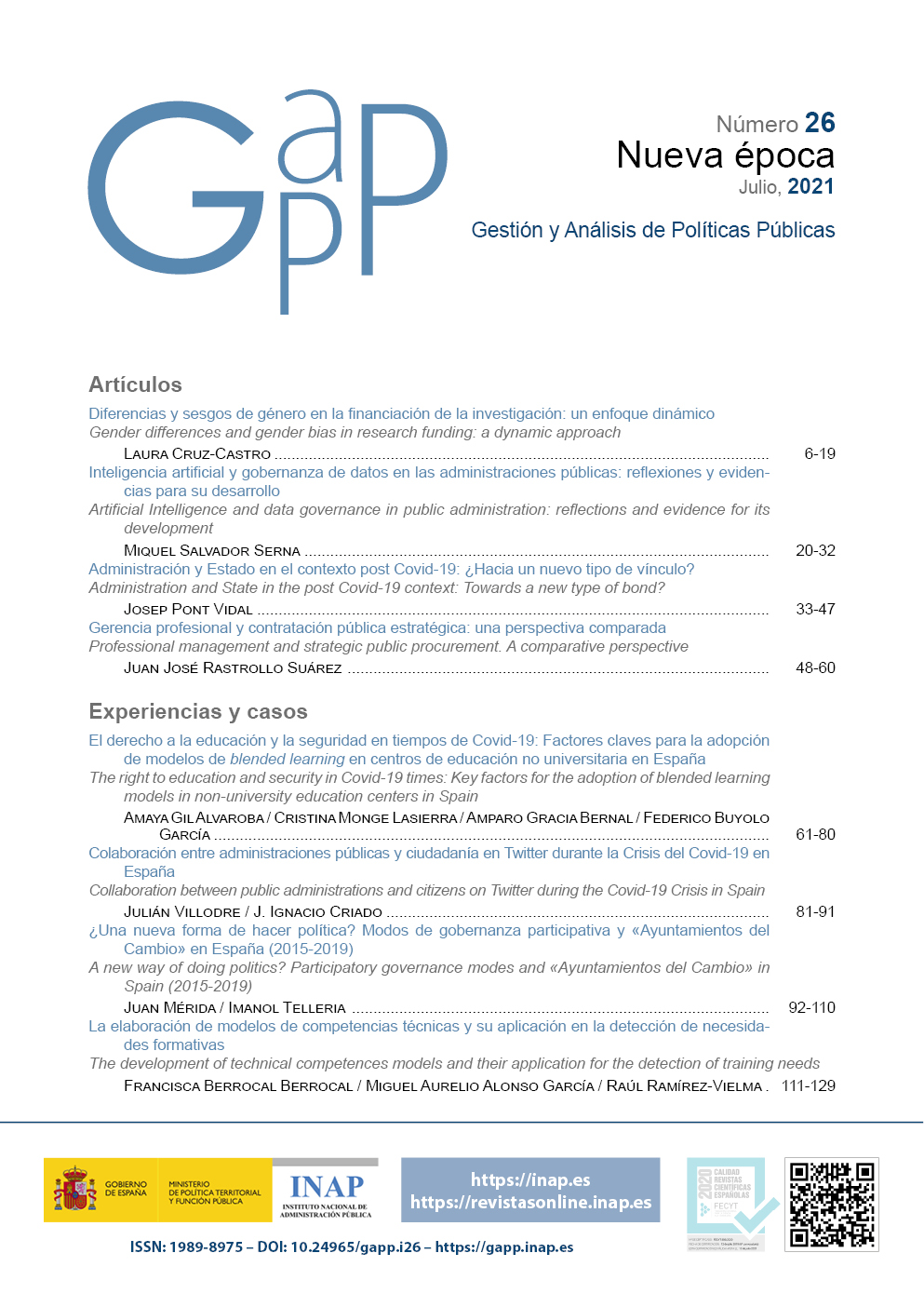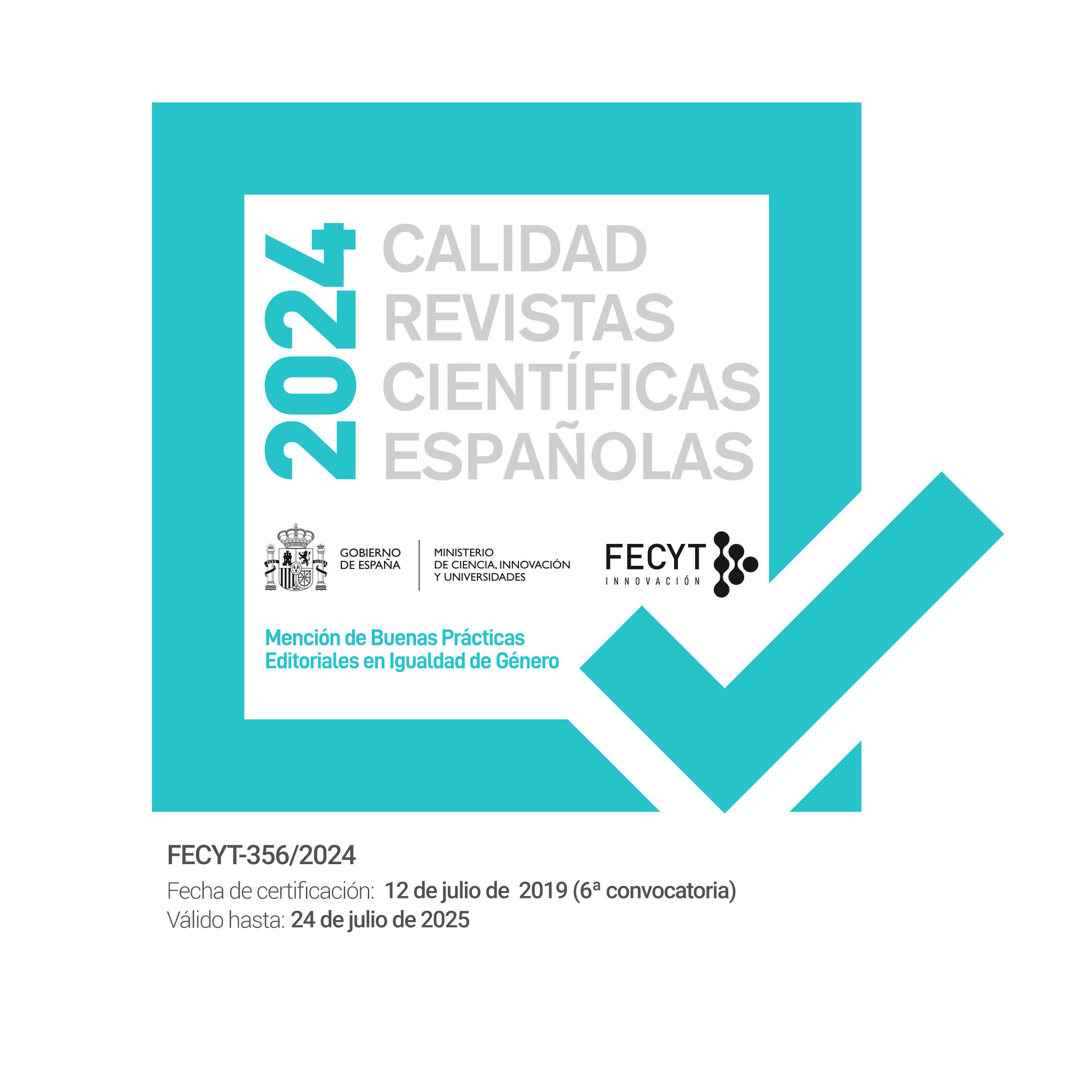Inteligencia artificial y gobernanza de datos en las administraciones públicas: reflexiones y evidencias para su desarrollo
DOI:
https://doi.org/10.24965/gapp.i26.10855Palabras clave:
Inteligencia Artificial, Gobernanza de Datos, Administración PúblicaResumen
El desarrollo y la integración de la Inteligencia Artificial (IA) a nivel transversal en las organizaciones del sector público, trascendiendo de iniciativas puntuales de carácter sectorial, requiere contar con nuevas capacidades. La revisión de diferentes aproximaciones que abordan esta cuestión permite destacar la importancia de los datos y, más concretamente, de su gobernanza en las administraciones públicas. Para profundizar en ello se analizan las diferentes dimensiones de la gobernanza de datos y se identifican cinco componentes para su desarrollo: la estrategia, la arquitectura e infraestructura de datos, la organización (incluyendo la estructura y los procesos), la gestión del talento y las competencias de los profesionales y el modelo de relaciones de la organización con su entorno. A través de la reflexión conceptual y su aplicación a un estudio de caso sobre el Ayuntamiento de Barcelona, con aportes en los diferentes componentes, se destacan aprendizajes y se formulan propuestas para cada uno de ellos. Las conclusiones permiten destacar la necesidad de contar con una estrategia integrada de refuerzo institucional que relacione los diferentes componentes de una gobernanza de datos vinculada al desarrollo de la Inteligencia Artificial en el sector público.
Descargas
Citas
Acuto, M., Steenmans, K., Iwaszuk, E. y Ortega-Garza, L. (2018). Informing urban governance? Boundary-spanning organisations and the ecosystem of urban data. Area, 51, 94-103. https://doi.org/10.1111/area.12430
Allam, Z. y Dhunny, Z. A. (2019). On big data, artificial intelligence and smart cities. Cities, 89, 80-91. https://doi.org/10.1016/j.cities.2019.01.032
Begg, C. y Caira, T. (2012). Exploring the SME Quandary: Data Governance in Practise in the Small to Medium-Sized Enterprise Sector. Electronic Journal of Information Systems Evaluation, 15(1), 3-13.
Nielsen, O. B., Persson, J. S. y Madsen, S. (2019). Why Governing Data Is Difficult: Findings from Danish Local Government. En A. Elbanna, Y. Dwivedi, D. Bunker y D. Wastell (eds.). Smart Working, Living and Organising. TDIT 2018. IFIP Advances in Information and Communication Technology (vol. 533). Springer. https://doi.org/10.1007/978-3-030-04315-5_2
Blanco, I., Salazar, Y. y Bianchi, I. (2019). Urban governance and political change under a radical left government: The case of Barcelona. Journal of Urban Affairs, 42(1), 18-38. https://doi.org/10.1080/07352166.2018.1559648
Castro, D. y New, J. (10 de octubre de 2016). The promise of artificial intelligence. Center for Data Innovation. Consultado el 4 de agosto de 2020. https://www.datainnovation.org/2016/10/the-promise-of-artificial-intelligence/
Christodoulou, P., Decker, S., Douka, A. V., Komopoulou, C., Peristeras, V., Sgagia, S., Tsarapatsanis, V. y Vardouniotis, D. (2018). Data Makes the Public Sector Go Round. En P. Parycek, O. Glassey, M. Janssen, H. J. Scholl, E. Tambouris, E. Kalampokis, S. Virkar (eds.). Electronic Government. EGOV 2018. Lecture Notes in Computer Science (vol. 11.020). Springer. https://doi.org/10.1007/978-3-319-98690-6_19
Creswell, J. W. (2018). Qualitative inquiry and research design: choosing among five approaches. SAGE. https://doi.org/10.1177/1524839915580941
Desouza, K. C. (2018). Delivering Artificial Intelligence in Government: Challenges and Opportunities. IBM Center for the Business of Government. Consultado el 4 de agosto de 2020. http://www.businessofgovernment.org/report/delivering-artificial-intelligence-government-challenges-and-opportunities
Desouza, K. C., Dawsona, G. S. y Chenok, D. (2020). Designing, developing, and deploying artificial intelligence systems: Lessons from and for the public sector. Business Horizons, 63(2), 205-213. https://doi.org/10.1016/j.bushor.2019.11.004
Eizaguirre, S. y Pares, M. (2019). Communities making social change from below. Social innovation and democratic leadership in two disenfranchised neighbourhoods in Barcelona. Urban Research & Practice, 12(2), 173-191. https://doi.org/10.1080/17535069.2018.1426782
Galliers, R. D., Newell, S., Shanks, G. y Topi, H. (2017). Datification and its human, organizational and societal effects: the strategic opportunities and challenges of algorithmic decision-making. Journal of Information Systems, 26(3), 185-190. https://doi.org/10.1016/j.jsis.2017.08.002
Gerbert, P., Hecker, M., Steinhäuser, S. y Ruwolt, P. (2017). Putting artificial intelligence to work. BCG Henderson Institute. Consultado el 4 de agosto de 2020. https://www.bcg.com/de-de/publications/2017/technologydigital-strategy-putting-artificial-intelligence-work.aspx
Gonzalez-Zapata, F. y Heeks, R. (2015). The multiple meanings of open government data: Understanding different stakeholders and their perspectives. Government Information Quarterly, 32(4), 441-452. https://doi.org/10.1016/j.giq.2015.09.001
Grosz, B. J., Mackworth, A., Altman, R., Horvitz, E., Mitchell, T., Mulligan, D. y Shoham, Y. (2016). Artificial intelligence and life in 2030: One hundred years’ study on artificial intelligence. Stanford University. Consultado del 4 de agosto de 2020. https://ai100.stanford.edu/sites/default/files/ai_100_report_0831fnl.pdf
Guirguis, K. (2020). From Big Data to Big Performance – Exploring the Potential of Big Data for Enhancing Public Organizations’ Performance. A Systematic Literature Review. Swiss Yearbook of Administrative Sciences, 11(1), 55-65. https://doi.org/10.5334/ssas.140
Jones, M. (2019). What we talk about when we talk about (big) data. The Journal of Strategic Information Systems, 28(1), 3-16. https://doi.org/10.1016/j.jsis.2018.10.005
Intel·ligència artificial: decisions automatitzades a Catalunya (2020). Barcelona: APDCAT - Generalitat de Catalunya. Consultado el 4 de agosto de 2020. https://apdcat.gencat.cat/web/.content/04-actualitat/noticies/documents/INFORME-INTELLIGENCIA-ARTIFICIAL-FINAL-WEB-OK.pdf
Keding, C. (2020). Understanding the interplay of artificial intelligence and strategic management: four decades of research in review. Management Review Quarterly, 71, 91-134. https://doi.org/10.1007/s11301-020-00181-x.
Khatri, V. y Brown, C. V. (2010). Designing Data Governance. Communications of the ACM, 53(1), 148-152. https://doi.org/10.1145/1629175.1629210
Kim, G. H., Trimi, S. y Chung, J. H. (2014). Big Data Applications in the Government Sector: A Comparative Analysis among Leading Countries. Communications of the ACM, 57(3), 78-85. https://doi.org/10.1145/2500873
Loebbecke, C. y Picot, A. (2015). Reflections on Societal and Business Model Transformation Arising from Digitization and Big Data Analytics: A Research Agenda. The Journal of Strategic Information Systems, 24(3), 149-157. https://doi.org/10.1016/j.jsis.2015.08.002
Luckin, R., Holmes, W., Griffiths, M. y Forcier, L. B. (2016). Intelligence Unleashed: An argument for AI in Education. Pearson Education. https://www.pearson.com/content/dam/corporate/global/pearson-dot-com/files/innovation/Intelligence-Unleashed-Publication.pdf
Magro, R. (2020). La Oficina del Dato, El Consultor de los Ayuntamientos (Sección A Fondo), III, 99-110.
Markus, M. L. (2017). Datification, Organizational Strategy, and IS Research: What’s the Score? The Journal of Strategic Information Systems, 26(3), 233-241. https://doi.org/10.1016/j.jsis.2017.08.003
Mehr, H. (agosto de 2017). Artificial intelligence for citizen services and government. Harvard Kennedy School, Ash Center for Democratic Governance and Innovation. Consultado el 4 de agosto de 2020. https://ash.harvard.edu/files/ash/files/artificial_intelligence_for_citizen_services.pdf
Hult, M. y Lennung, S. Å. (1980). Towards a definition of action research: a note and bibliography. Journal of Management Studies, 17(2), 241-250. https://doi.org/10.1111/j.1467-6486.1980.tb00087.x
Huxham, C. y Vangen, S. (2003). Researching organizational practice through action research: case studies and design choices. Organizational Research Methods, 6(3), 383-403. https://doi.org/10.1177/1094428103254454
March, H. y Ribera-Fumaz, R. (2018). Barcelona: from corporate smart city to technological sovereignty. En A. Karvonen, F. Cugurullo y F. Caprotti (eds). Inside Smart Cities: Place, Politics and Urban Innovation (págs. 227-242). Routledge. https://doi.org/10.4324/9781351166201-15
Newell, S. y Marabelli, M. (2015). Strategic opportunities (and challenges) of algorithmic decision-making: a call for action on the long-term societal effects of «Datification». Journal of Strategic Information Systems, 24(1), 3-14. https://doi.org/10.1016/j.jsis.2015.02.001
Nikitas, A., Michalakopoulou, K., Njoya, E. T. y Karampatzakis, D. (2020). Artificial Intelligence, Transport and the Smart City: Definitions and Dimensions of a New Mobility Era. Sustainability, 12, 1-19. https://doi.org/10.3390/su12072789
Otto, B. (2011a). A morphology of the organization of data governance. European Conference on Information Systems (ECIS 2011 Proceedings, 272). Association for Information Systems (AIS). https://aisel.aisnet.org/ecis2011/272
Otto, B. (2011b). Organizing Data Governance: Findings from the Telecommunications Industry and Consequences for Large Service Providers. Communications of the Association for Information Systems, 29, 45-66 (artículo 3). https://doi.org/10.17705/1cais.02903
Pencheva, I., Esteve, M. y Jankin Mikhaylov, S. (2020). Big Data and AI – A transformational shift for government: So, what next for research? Public Policy and Administration, 35(1), 24-44. https://doi.org/10.1177/0952076718780537
Pique, J. M., Miralles, F. y Berbegal-Mirabent, J. (2019). Areas of innovation in cities: the evolution of 22@Barcelona. International Journal of Knowledge-Based Development, 10(1), 3-25. https://doi.org/10.1504/ijkbd.2019.10019576
Qian Sun, T. y Medaglia, R. (2019). Mapping the challenges of Artificial Intelligence in the public sector: Evidence from public healthcare. Government Information Quarterly, 36(2), 368-383. https://doi.org/10.1016/j.giq.2018.09.008
Ramió, C. (2019). Inteligencia artificial y Administración pública. Robots y humanos compartiendo el servicio público. Catarata.
Ramió, C. (2018). El impacto de la inteligencia artificial y de la robótica en el empleo público. GIGAPP Estudios Working Papers, 5(98-110), 401-421. http://www.gigapp.org/ewp/index.php/GIGAPP-EWP/article/view/115
Ramió, C. y Salvador, M. (2019). Gobernanza social e inteligente. Una nueva organización para el Ayuntamiento de Barcelona. Ajuntament de Barcelona. https://ajuntament.barcelona.cat/barcelonallibres/sites/default/files/publicacions_fitxers/pdf_gobernanza_indexat_cast.pdf
Weber, K., Otto, B. y Österle, H. (2009). One Size Does Not Fit All. A Contingency Approach to Data Governance. Journal of Data and Information Quality, 1(1), 1-26. https://doi.org/10.1145/1515693.1515696
Wiseman, J. M. (2018). Data-Driven Government: The Role of Chief Data Officers. IBM Center for the Business of Government. http://www.businessofgovernment.org/sites/default/files/Data-Driven%20Government_0.pdf
Wirtz, B. W., Weyerer, J. C. y Geyer, C. (2019). Artificial Intelligence and the Public Sector – Applications and Challenges. International Journal of Public Administration, 42(7), 596-615. https://doi.org/10.1080/01900692.2018.1498103
Yin, R. K. (2018). Case study research and applications: design and methods. SAGE.
Descargas
Publicado
Cómo citar
Número
Sección
Licencia
Derechos de autor 2021 Gestión y Análisis de Políticas Públicas. Nueva época

Esta obra está bajo una licencia internacional Creative Commons Atribución-NoComercial 4.0.












